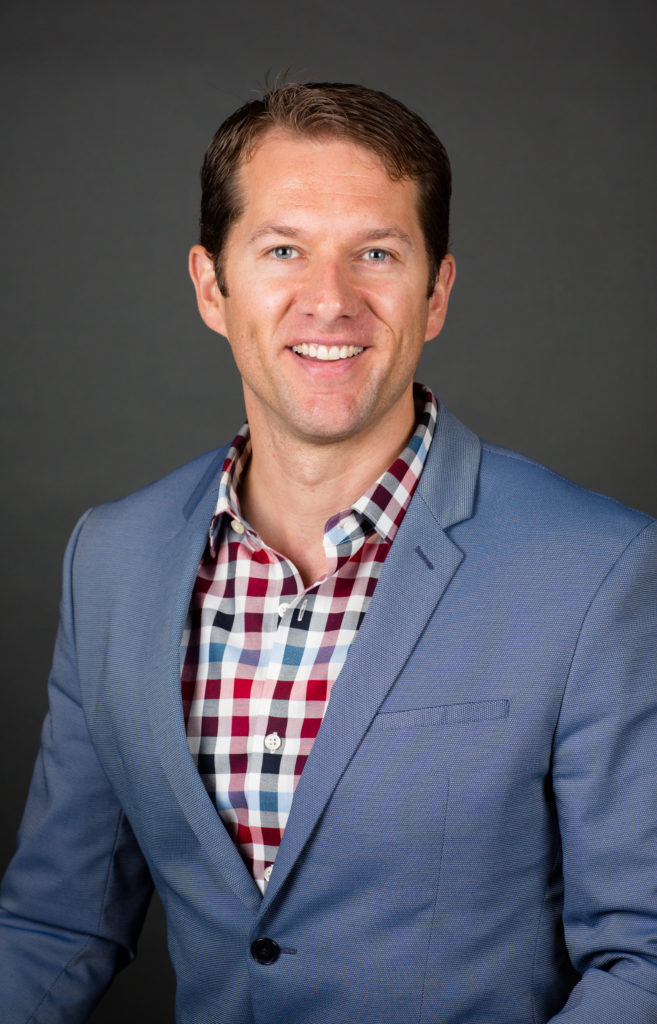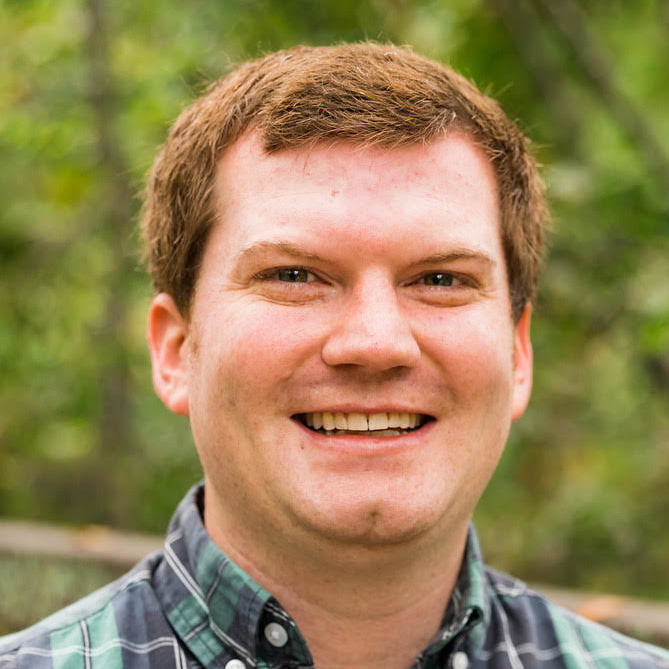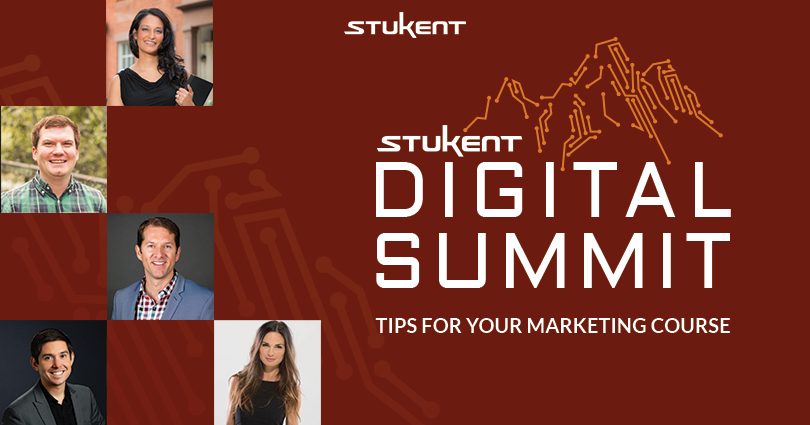Instruction ideas on paid search advertising, technology’s impact on marketing, bringing real data into class, machine learning, and influencer marketing were all part the Fall 2019 Stukent Digital Summit (SDS) held Nov. 10.
The virtual conference brought the insights of five higher education instructors to attendees from educational institutions in the U.S. and abroad. Following are highlights from each of the conference sessions.

How to Teach Paid Search Ads in Four Easy Steps
Jeff Larson, Ph.D., associate professor of marketing, Marriott School of Business, Brigham Young University; coauthor of “Digital Marketing Essentials”
During the first session of the summit, Jeff presented four steps for teaching paid search ads that includes teaching Google Ads setup:
1) provide a template
2) choose ad settings
3) explain Google automation
4) create ads
On the first step, Jeff recommended that students identify keywords and write copy before getting into the Google Ads platform. Steps two and three, he explained, are part of the setup before ad creation begins. Step four involves ads creation as well as critique.
Jeff explained that he gives students an Excel spreadsheet with core information as a template to get them started in establishing paid search and has a group of students present their completed template in class.
When instructing students on Google Ads settings for a search campaign, he does not advocate leaving the display ads network activated. “I actually actively encourage them not to show their ads on the display network,” he said. “If we’re going to run a display campaign, let’s run a display campaign and choose those settings and be very strategic about that instead of just doing this sort of sloppy-seconds add-on display campaign.”
During the question-and-answer session following his formal presentation, Jeff spoke of identifying products to incorporate into a paid search project and how to approach funding for student paid search campaigns.
View Jeff’s Session
Introducing PPC Pilot
The SDS event featured the announcement of Stukent’s PPC Pilot, an online educational tool that presents a quick exercise on pay-per-click advertising.
The exercise “teaches students the makeup of a PPC ad, and it’s actually graded,” said Stukent’s chief marketing officer Trevor Erikson. “If you know nothing about PPC — pay-per-click ads — and just want a quick way to get introduced to the subject, this is a fantastic resource.”
Go ahead: test your PPC skills and learn about this marketing approach with PPC Pilot.

Technology’s Impact on Consumer Behavior — And Why Our Students Should Care
Radhika Duggal, head of marketing: students and financial inclusion at Chase Bank; adjunct instructor at New York University
Radhika addressed the convergence of marketing, consumer behavior, and technology, and the influence that convergence has for students and instructors. She indicated that “technology’s impact on consumer behavior … is the thing that will help our students get full-time jobs.”
Her presentation was built around three focus areas:
FOCUS 1: TECHNOLOGY’S IMPACT ON THE MARKETING CONCEPT
Giving testimony to the validity of price, product, place, and promotion in marketing, Radhika said, “The reality is, consumer behavior has transformed the way we think about these four elements of the marketing mix, primarily because of technology.”
She also talked of the opportunity students have to leverage their familiarity with technology. “They can position themselves in interviews to be the subject matter expert, to bring that digital nativeness to a company so that they can actually make themselves critical from day one.”
FOCUS 2: TECHNOLOGY IMPACTS THE ENVIRONMENT IN WHICH PURCHASES ARE MADE
Radhika told employees that “technology has enabled [marketers] to … get an understanding of the context in which consumers make purchase decisions — that is incredibly, incredibly important.”
To explain technology’s connection to environment, she pointed to benefits Google would gain in a purchase of Fitbit, namely the biometric and location data that could influence marketing’s connection to consumers.
FOCUS 3: TECHNOLOGY HELPING OVERCOME MARKETING CHALLENGES
In this section of the presentation, Radhika expressed that technology has helped marketers overcome two challenges: targeting and scaling.
“I can get really granular on targeting because of technology. I can also get really granular on ‘what,’ the messaging that I am going to serve up to those consumers,” she explained.
Radhika also spoke of technology allowing for cost effective scaling in marketing approaches.
View Radhika’s Session

Use Real Data for an Interactive Digital Persona Workshop Students Will Love
Nathan David, founder and lead consultant, Meta Impact; adjunct instructor at Cleveland State University
A practicing consultant, Nathan brings industry perspective into class at Cleveland State University. That perspective and his experience as an instructor fueled his SDS presentation in which he shared his favorite consulting activity for students.
The “Interactive Digital Persona Workshop” activity takes students from the idea of customers to target markets to personas.
Nathan said that involving personas in the activity allows inclusion of data into the classroom without that data being intimidating. He said that while companies can have multiple consumer personas, in this activity students are looking for a primary persona. “The ultimate goal is to humanize that target audience so that we can market to them more effectively,” he said.
Nathan frames the activity with the idea that he is looking for student help with a particular client. He then assigns that each student, based on a given data set, answers a set of questions regarding a primary persona.
As for the data that students are presented, Nathan said, “This is the most important part … having data that helps the students understand what real-world data companies have about their consumers and then how they can use that data to better understand their customers.”
During the session, Nathan provided this link for accessing materials, including data, for the activity.
View Nathan’s Session

Three Ways to Prepare Your Students to Succeed with Machine Learning
Ryan Russell, lecturer of marketing at The University of Tennessee at Chattanooga
Ryan presented that machine learning is not something that is poised to take away human’s jobs but that “machine learning and artificial intelligence have changed the game with how we do our jobs.” He said, “As professors, when we put our heads in the sand on something like this, it’s doing our students a massive disservice.”
In explaining machine learning, Ryan said, “Machines are able to look at our business challenges and identify reasonable predictions based on past behaviors. Those reasonable predictions,” he continued, “produce a significant level of data.” Accumulated data allow for the creation of models, and “we are able to apply those models into the upcoming scenario.”
Machine learning affords many advantages, but machines cannot determine consumer intent, he explained.
On the topic of preparing students for machine learning success, Ryan made three main suggestions:
- Emphasize the importance of solid marketing strategy
- Develop on- and off-campus partnerships
- Leverage educational resources from Amazon, Google, and Stanford
During the question-and-answer exchange following Ryan’s presentation, he responded to an inquiry as to where an instructor new to machine learning should start. “I would take the crash course in machine learning from Google. You would be surprised at how much you can learn.”
View Ryan’s Session

How to Teach Influencer Marketing and Create Engaging Projects for Students
Amanda Russell, CMO, Valeo Technologies; professor of marketing, University of Texas at Austin; author of “The Influencer Code”
Amanda spoke of the importance of “a course that is bigger than just a fad or a trend or a tool of the day,” emphasizing a main message of her SDS presentation: that “influencer marketing is not just about Instagram or a social media platform; influencer marketing is not social media; it is not about reach; it is not about engagement; it is about true influence.”
In her presentation, Amanda gave an overview of her influence marketing course, giving attention to the importance of students learning how to think about influencer marketing. In explaining her course, she also spoke of students understanding how to go about selecting an influencer with whom a business can build a solid relationship. “Influencer marketing is a brand partnership,” she said.
Amanda explained that in her course students are to write an influencer analysis and then create an influencer marketing plan. That plan is then to be presented in class to the associated client. For an overall influencer campaign experience, Amanda directs that students
- Have a campaign objective
- Identify target audience and needs
- Select three influencers and explain choices
- Explain their plan for approaching the influencers
(includes sample outreach) - Indicate roles of selected influencers
- Explain how the campaign will be measured
- Provide a campaign agreement
- Give a campaign timeline of elements
View Amanda’s Session
Virtual Conferences
This digital summit is the most recent such virtual conference in an ongoing series. Click here to request access to the session recordings from this and previous SDS conferences.







